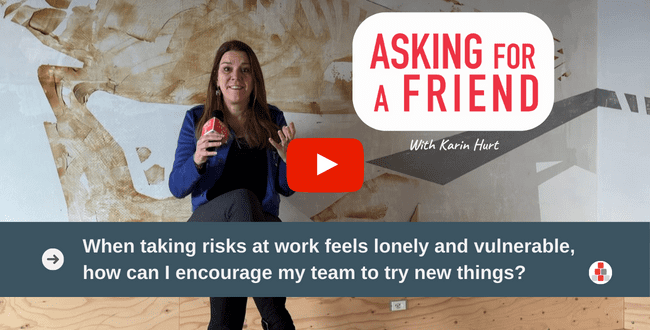Make Taking Risks a Team Sport
Taking risks at work can feel remarkably lonely. Especially if you’re the only one trying new things, or experimenting with new approaches. This week on #AskingforaFriend I share practical approaches to making taking risks a team sport.
In this video, I share three leadership best practices to help your team work together to strategize, analyze and execute appropriate risks. If you build risk-taking into your organization’s culture, you can normalize risk, so everyone feels like they are on the same team even when they are trying something new.
These ideas and approaches came from teams in one of our long-term Courageous Cultures programs. They were focused on practical ways to operationalize their important value of risking taking.
3 Leadership Best Practices for Taking Risks

1. Mini Masterminds for Taking Risks
Carve out a few minutes at the beginning of a staff meeting for a mini mastermind. Anyone can get on the agenda and say, “I have a risk that I’d like to take, but before I do, I could use your help in vetting it.” The team can work together to dissect the risk and identify what’s really at stake. What effect does the risk have on the rest of the team? Weigh the costs and benefits. Is it really worth it?
When the person makes the decision, they’ll feel like they have a whole group of people at their back who have thought it through with them. They won’t feel alone when they’re taking risks.
2. Find Time to Share About Risky Business
Give people time to talk about a risk they took (or that’s in progress) and the outcome. Then celebrate the act of trying something new with one another! Also, acknowledge when someone considers taking a risk, and then decides not to. This will help people feel more confident sharing their ideas and vetting them with the team.
3. Hold Regular “Post-Project Celebrations”
Celebrate the work. Celebrate what worked and the contributions. AND celebrate the learning. You get more of what you encourage and celebrate and less of what you ignore. Naturally, when your team sees you as a leader celebrating those who are taking risks, they will be more likely to do the same. The result will be a courageous culture with more innovative thinking and more willingness to try something new.
What would you add? How do you help your team feel supported (and less alone) when taking risks at work?
See Also:










0 Comments